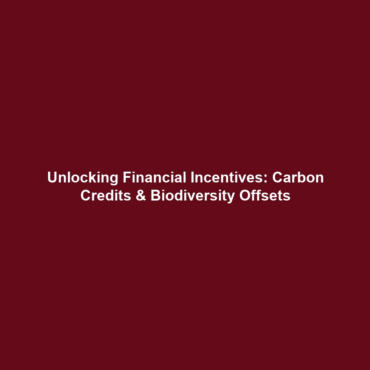Financial Incentives for Forest Protection: Carbon Credits and Biodiversity Offsets
Introduction
Financial incentives for forest protection are emerging as critical tools in the fight against deforestation and the loss of biodiversity. Concepts such as carbon credits and biodiversity offsets serve not only to mitigate environmental degradation but also to foster sustainable economic development. Given the alarming rates of forest depletion and species extinction globally, these financial mechanisms offer innovative pathways to reward conservation efforts while addressing the pressing challenges of deforestation and biodiversity loss. This article delves into the importance of these incentives and their broader implications for environmental sustainability.
Key Concepts
Understanding the mechanisms behind financial incentives for forest conservation is crucial for their effective application. The following concepts play a pivotal role:
1. Carbon Credits
Carbon credits are certificates that represent the right to emit a certain amount of carbon dioxide, promoting reductions in greenhouse gas emissions. Through cap-and-trade systems, companies can buy or sell these credits, thus financially motivating forest preservation practices. The idea is that by maintaining forests, which act as carbon sinks, organizations can offset their emissions, consequently combatting deforestation and thus contributing to biodiversity maintenance.
2. Biodiversity Offsets
Biodiversity offsets involve compensatory actions undertaken to counterbalance unavoidable impacts on biodiversity due to development projects. By investing in biodiversity conservation or restoration projects, developers help to ensure that net loss to biodiversity is minimized, thereby mitigating the detrimental effects of biodiversity loss resulting from industrial and urban expansion.
Applications and Real-World Uses
Financial incentives for forest conservation can lead to numerous practical outcomes. Here are some noteworthy applications:
- Carbon Market Participation: Companies participating in carbon markets invest in reforestation projects to generate carbon credits.
- Conservation Easements: Landowners can sell development rights to protect their land, generating revenue while preserving forest habitats.
- Public-Private Partnerships: These collaborations can help fund biodiversity conservation efforts through financial incentives provided by both sectors.
Current Challenges
Despite the promise shown by financial incentives, several challenges have emerged, hindering their widespread applicability:
- Lack of Standardization: Variability in the definitions and practices of carbon credits and biodiversity offsets leads to inconsistencies.
- Measurement Difficulties: Accurately measuring the environmental benefits of conservation projects remains a complex issue.
- Market Fluctuations: The volatility of carbon credit markets can disincentivize long-term investment in environmental initiatives.
Future Research and Innovations
The future of financial incentives for forest protection looks promising, with several emerging trends and innovations:
- Blockchain Technology: This technology can improve transparency in carbon credit transactions, enhancing trust and efficiency.
- Remote Sensing Tools: Advanced monitoring technologies can help ensure compliance and measure conservation success more effectively.
- Integrated Ecosystem Services Models: These models aim to quantify and monetize the myriad benefits provided by healthy forests, encouraging broader participation in and support for conservation efforts.
Conclusion
Financial incentives for forest protection, including carbon credits and biodiversity offsets, are vital in combating deforestation and biodiversity loss. Their effective implementation not only promotes sustainable environmental practices but also provides economic opportunities. Stakeholders—governments, businesses, and communities—must collaborate to optimize these mechanisms. For more insights on environmental sustainability initiatives, consider exploring our articles on sustainability initiatives and carbon credit systems.

